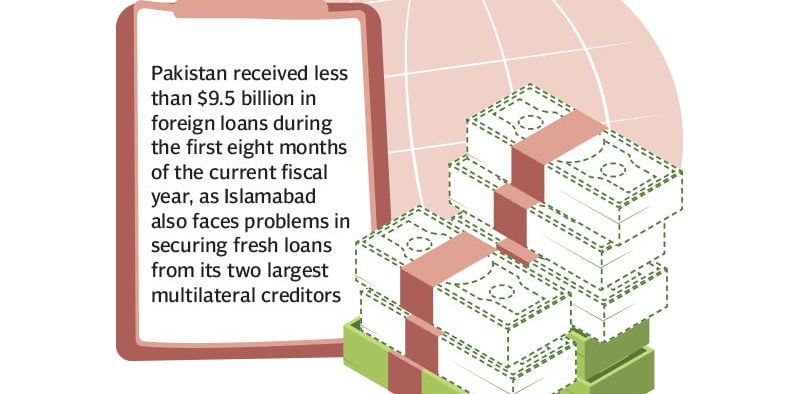At $9.5 billion, foreign loans are still modest

During the first eight months of the current fiscal year, Pakistan received less than $9.5 billion in foreign loans. It also had difficulties in obtaining new loans from its two biggest multilateral lenders.
The current fiscal year’s July–February period saw a slowdown in overall payments from international creditors, even though Pakistan is under the International Monetary Fund’s (IMF) watch. Just $318 million was given to the government by foreign lenders in February.
The most recent distribution data were released on Thursday by the Economic Affairs Division. According to information released by the central bank and the ministry of economic affairs, Pakistan obtained foreign loans totaling close to $9.5 billion in the first eight months of the current fiscal year.
Saudi Arabia, China, and the United Arab Emirates (UAE) also obtained $6 billion in deposit rollovers for Pakistan, bringing the total amount of inflows from the external sector to $15.4 billion, or 62% of its needs.
These loans were given to the nation in the form of project funding, budget and balance of payments support. Even still, the central bank’s gross foreign exchange reserves—which it had acquired from the domestic market—stayed at $8 billion.
The federal government is having trouble meeting the goals of new loans from the World Bank and the Asian Development Bank (ADB), after issues in obtaining foreign commercial loans and floating Eurobonds.
During their meeting on Thursday, Finance Minister Muhammad Aurangzeb asked for financial help for both the current fiscal year and the upcoming IMF program. Pakistan’s financial problems cannot be resolved by the IMF funds alone.
With a total of $2.6 billion for the current fiscal year, the government got just $222 million from international lenders in February. It still anticipates earning $5.2 billion this year. But the goal might not be reached.
In eight months, the ADB provided just $635 million, or 31% of the $2.1 billion annual forecast. It appears that when the budget was announced, the Ministries of Finance and Economic Affairs had set unattainable goals.
According to a statement from the finance ministry, Aurangzeb emphasized the ADB’s support through policy-based funding to lessen the effects of the pandemic and floods. It was also examined where policy-based programs stood, such as the Climate and Disaster Resilience Enhancement initiative (CDREP) and the Public-Private Partnership (PPP) initiative.
Not all of the requirements set forth in the PPP and CDREP programs have been fulfilled by Pakistan yet. The PPP policy has not yet received official approval. In a similar vein, the terms of CDREP remain unclear and several government departments’ roles are not well defined.
According to sources, Pakistan may only receive $1.3 billion in loans from the ADB for the current fiscal year, compared to the budgetary aim of $2.1 billion.
The nation has not been able to ensure that the Geneva promises for the flood victims in 2022 are fulfilled in full.
After the IMF, the World Bank was the biggest lender, disbursing $1.4 billion in loans in just eight months. Out of a $3 billion loan package, $1.9 billion has been provided by the IMF.
Pakistan hopes to receive at least $2 billion from the World Bank, with a budget of $2.3 billion for this fiscal year.
The government’s inability to properly use its borrowing alternatives is indicative of inadequate planning and budgeting.
Out of the $500 million yearly forecast, the Islamic Development Bank only disbursed $200 million in the current fiscal year. Pakistan has used up all of the allocated $600 million Saudi oil facility, but last month it did not get any further funding.
The estimated yearly budget for commercial loans is $4.5 billion; however, attempts to get a minimum of $600 million from China have not yielded positive results.
China has connected the funding to an earlier agreement to cover Pakistan’s debt of Rs. 515 billion to Chinese power projects. Pakistan is requesting a rollover of a $1 billion Chinese commercial loan that is due in June.
After the IMF granted its Extended Fund Facility, Finance Minister Aurangzeb expressed hope that the blocked commercial finance pipelines would be unblocked.
With rollovers excluded, bilateral lenders gave Pakistan $768 million between July and February.
Beyond the yearly objective, Pakistan got $686 million from Pakistanis living abroad as investment in Naya Pakistan Certificates.
$11 billion must be reimbursed to the nation throughout the balance of the current fiscal year. However, it only projects a $6 billion rollover, leaving a $5 billion shortfall.
In order to cover the deficit, the ministry is seeking to get a $1.1 billion tranche from the IMF as well as some additional help from the World Bank and the ADB.
In order to sustain reserves at their present levels and facilitate repayments, the central bank will also purchase dollars from the market.

I am a dedicated student currently in my seventh semester, pursuing a degree in International Relations. Alongside my academic pursuits, I am actively engaged in the professional field as a content writer at the Rangeinn website.








